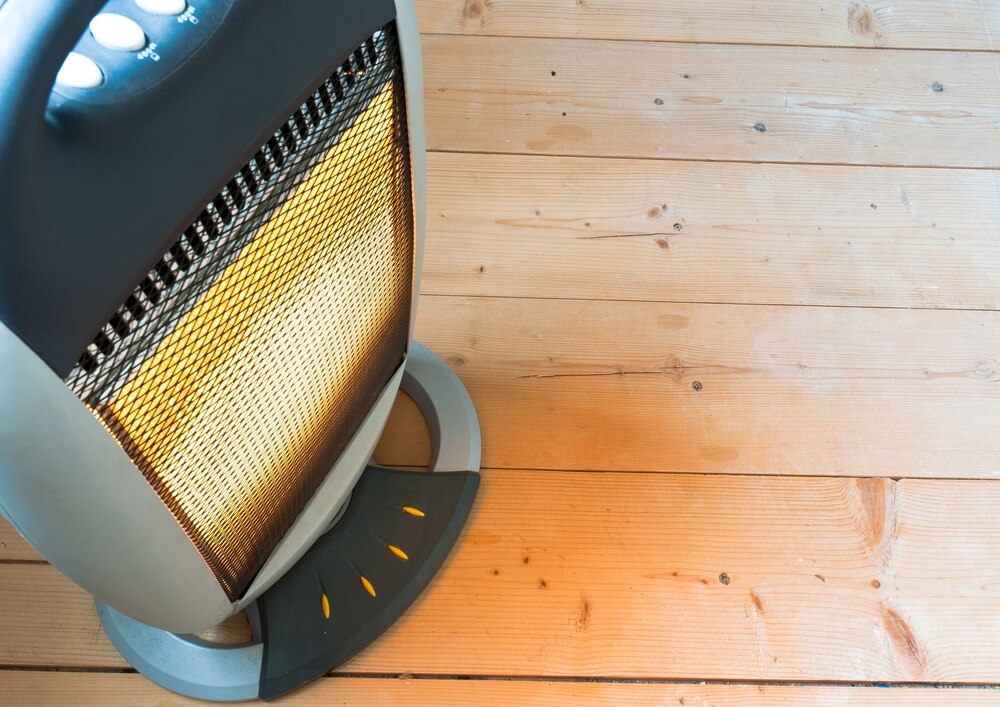Infrared heaters are environmentally-friendly, efficient heaters that heat objects through infrared light rather than heating the air in a space. They have several benefits, including instant heat, heating bill savings, and low maintenance costs.
Infrared heaters may cost anywhere between $50 and $500 to buy, depending on the model; they typically cost about $60 to $80 per month or more to run, though the exact cost will depend on wattage and hours used per day. Buying an infrared heater may be worth it for you, depending on the type of space you need to heat. Below, learn more about infrared heaters, including whether it makes sense to invest in one and other types of portable heaters to consider.
Are Infrared Heaters Worth It?
An infrared heater might be a beneficial purchase for you if you:
- Are heating a small zone in your home and turning down your primary heat source
- Have bad allergies or asthma and need a heat source that does not push around the air
- Have a workshop or garage that needs to be heated and sees a lot of in-and-out traffic
- Want/need heat quickly, and you want/need heat to stop quickly
Below, we detail the factors you should consider when deciding whether to purchase an infrared heater, including the cost to buy, cost to run, and the pros and cons of running this type of heater.
Cost to Purchase
The purchase price of infrared heaters varies substantially based on the size, brand, and wattage, but there are models available at several price points. Prices typically range from around $50 for smaller models up to $500 for the most advanced models. A mid-sized, energy-efficient infrared heater will cost you about $150.
Compared to other portable heaters, infrared heaters can be pricey. Still, in general, you can find models similarly priced to other types of heaters — including higher-end ceramic, electric, and radiant models, which typically cost around $100.
Cost to Run
Energy costs in the U.S. vary by your precise location, but the national average at the time of this writing is around 13 cents per kilowatt-hour. Infrared heaters are commonly 1500 watts (1.5 kilowatts). If your energy costs are around the national average and you run your heater for 10 hours per day (or 15 kilowatt-hours), you can expect to pay about $60 per month to run the heater.
States like California, Hawaii, Massachusetts, New York, and Vermont have higher electricity rates, ranging from 18 to 30 cents per kilowatt-hour, according to data from the U.S. Energy Information Administration. In these states, you can expect to pay $80 or more per month to run your infrared heater for ten hours per day.
If you know the exact rate per kilowatt-hour that your energy costs, you can use the following formula to estimate your monthly cost to run an infrared heater:
- Step 1: Multiply the number of hours per day that you plan to run the heater by the heater’s wattage
- Example: 10 hours per day x 1.5 kilowatts = 15 kilowatt-hours
- Step 2: Multiply the cost per kilowatt-hour by the result from the previous step
- Example: 17 cents x 15 kilowatt hours = 255 cents
- Step 3: Divide the previous result by 100 to get a dollar amount per day
- Example: 255 cents/100 = $2.55 per day
- Step 4: Multiply the previous result by 30, the approximate number of days per month
- Example: $2.55 per day x 30 days = $76.50 per month
Note that because electric companies charge per kilowatt-hour, a 1500-watt infrared heater will cost the same to run as any type of portable heater with the same wattage. As such, your decision of which type of heater to buy should depend more on the space you need to heat and your purchase budget, rather than electricity savings.
Pros
Infrared heaters use warm, invisible infrared light — the same type of light that offers warmth when you stand in the sun or hold your hands over a campfire — to heat things in a surrounding space. In other words, things like our clothes, hair, and skin absorb the light and transform it into heat. Rather than heating the space itself, infrared heaters use a series of coils and a reflector to direct the light toward people and objects in the room.
Infrared heaters provide several advantages for your wallet, your productivity, and the planet. The top benefits of infrared heaters include:
- Comfort: Since infrared heaters don’t use fans, they offer a more comfortable warmth, rather than a dry heat.
- Instant Heat: As soon as you turn on an infrared heater, it starts emitting infrared light. Since it warms objects (and your body) rather than the air itself, you’ll feel warm almost instantly.
- Efficiency: Infrared heaters are very efficient and transfer at least 90% of all the energy they produce to the items in a space. They can also reduce the heat required to maintain a comfortable temperature in a building by at least 15%.
- Environmental Friendliness: Infrared heaters don’t release any pollutants into the air, nor do they use any fossil fuels or burn any wood to produce heat. Therefore, they’re a clean source of heat.
- Low Maintenance: They require very little maintenance (if any).
- Quiet: Since they use light instead of a fan to warm you, infrared heaters tend to be much quieter than other types of heaters.
Cons
While infrared heaters have several benefits, they do also have a few potential downfalls. In larger rooms, compared to other types of heaters, infrared heaters can fall short at heating the entire room. The heat also stops flowing as soon as an infrared heater is turned off.
Thus, this type of heater works best in places where the air in a space does not need to be warmed or would be inefficient to warm, such as a loading dock where doors are opened and closed often. Since the warm air in this type of space will quickly escape to the outside, heating the air would be inefficient; an infrared heater will continue to provide comfortable heating to you and the objects in the space, regardless of the doors continually opening.
While infrared heaters are efficient, claims of energy savings (and energy bill savings) are sometimes overstated. The efficiency of an infrared heater and its required energy depends on its wattage. A 750-watt heater, of course, will be more energy-efficient than a 1500-watt heater. Additionally, to see any cost savings from an infrared heater or another space heater, note that you’ll need to lower your thermostat — keeping the rest of the building cooler while using the heater to keep a single room more comfortable.
How Other Portable Heaters Compare
There are many different types of portable space heaters that compete with the infrared heater. Each is used to heat a room or space without having to crank the central heating system (which can help lower your heating bills). However, not all heaters are created equal. Here’s how other types of portable heaters differ from infrared heaters.
Ceramic Heaters
- How it works: Uses electricity to heat metal embedded in ceramic plates, warming the air near the heater in the process; heat then radiates to surrounding areas using natural or fan-induced convection currents
- Pros:
- Reaches higher temperatures with less input energy than metal-coil heaters
- Stays cool to the touch
- Provides focused heating pretty quickly
- Doesn’t create any dust, fumes, or smells
- Spreads heat evenly from floor to ceiling
- Cons:
- Tends to be more expensive than many other types of heat
- Can be heavier than other types of heaters, making them less portable
- Best for: Small personal spaces
- Price: Typically between $30 and $100, depending on size and wattage
Convection Heaters
- How it works: Utilizes natural air currents to suck the air from a room, heat it in a central chamber, and blow it back into the room
- Pros:
- Can make an entire room feel warm and toasty very quickly
- Cons:
- Can be inefficient since most of the hot air ends up at the ceiling
- Can draw a lot of power over time and become a more expensive option
- Are a leading cause of house fires
- Best for: Full rooms you spend a lot of time in, such as the bedroom, living room, or kitchen
- Price: $100 to $200, depending on size and wattage
Electric Heaters
- How it works: Uses volts of electricity to heat metal columns; may be battery-powered or plug directly into a home’s fuse box, which can limit their range
- Pros:
- Tends to warm up very quickly
- Lightweight and usually portable
- Cons:
- Consumes large amounts of energy
- Can be quite noisy
- Best for: Mid-sized rooms
- Price: $20 to $150, depending on size and wattage
Fan-Forced Heaters
- How it works: Uses an electric element to generate heat and blow it away from the heater using a fan
- Pros:
- Airflow can be adjusted to focus on a specific part of a room or oscillate to warm up the entire space
- Space stays warm even after you turn it off
- Cons:
- Blows dust and debris around the room, which is bad for indoor air quality
- A bit noisy since there’s a fan constantly blowing out air
- Best for: Offices, workshops, small bedrooms
- Price: $20 to $150, depending on size and wattage
Oil-Filled Radiant Heaters
- How it works: Warms oil with electricity to heat the air around the heater; heat then travels to cooler areas of the room
- Pros:
- Room stays warm after you turn it off
- Generally requires a lower wattage and tends to use less energy than other conventional heaters
- Quiet
- Doesn’t move dust around the room
- Cons:
- Slow to heat up
- Heavy and not as portable as other types
- Best for: Medium-sized spaces like living rooms or bedrooms
- Price: Typically between $50 to $100, depending on size and wattage
Where to Buy Portable Space Heaters
The following stores sell portable space heaters of every variety — infrared, ceramic, fan-forced, oil-filled, electric, and convection. Be sure to compare prices and read reviews before you make your purchase.
 William Lipovsky
William Lipovsky






